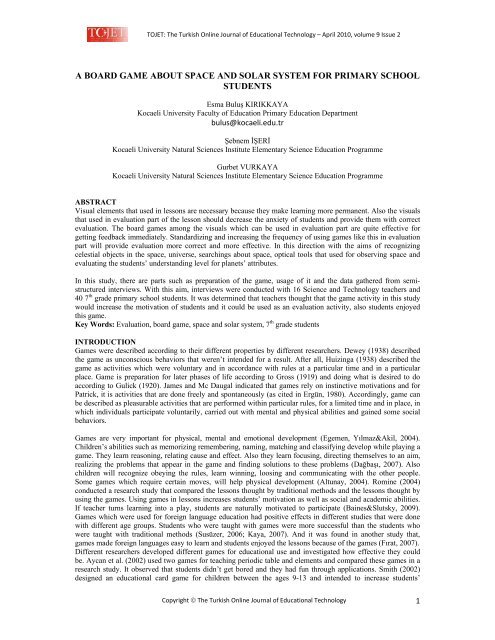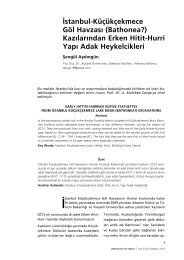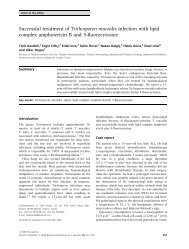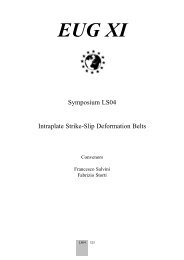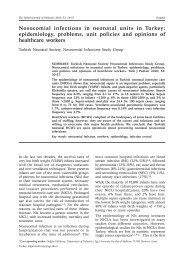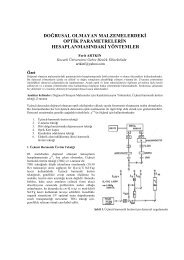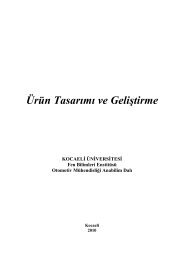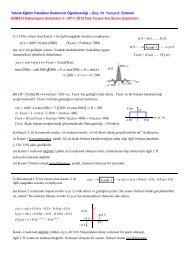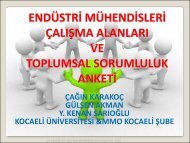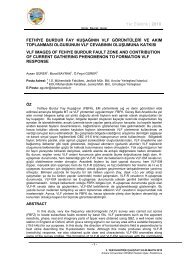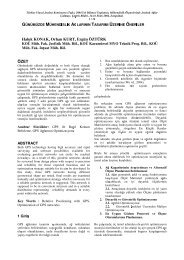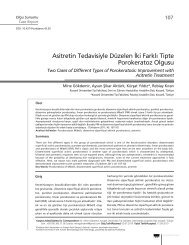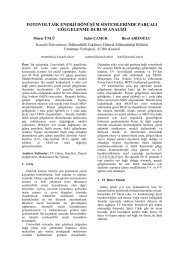a board game about space and solar system for primary school ...
a board game about space and solar system for primary school ...
a board game about space and solar system for primary school ...
Create successful ePaper yourself
Turn your PDF publications into a flip-book with our unique Google optimized e-Paper software.
TOJET: The Turkish Online Journal of Educational Technology – April 2010, volume 9 Issue 2<br />
A BOARD GAME ABOUT SPACE AND SOLAR SYSTEM FOR PRIMARY SCHOOL<br />
STUDENTS<br />
Esma Buluş KIRIKKAYA<br />
Kocaeli University Faculty of Education Primary Education Department<br />
bulus@kocaeli.edu.tr<br />
Şebnem İŞERİ<br />
Kocaeli University Natural Sciences Institute Elementary Science Education Programme<br />
Gurbet VURKAYA<br />
Kocaeli University Natural Sciences Institute Elementary Science Education Programme<br />
ABSTRACT<br />
Visual elements that used in lessons are necessary because they make learning more permanent. Also the visuals<br />
that used in evaluation part of the lesson should decrease the anxiety of students <strong>and</strong> provide them with correct<br />
evaluation. The <strong>board</strong> <strong>game</strong>s among the visuals which can be used in evaluation part are quite effective <strong>for</strong><br />
getting feedback immediately. St<strong>and</strong>ardizing <strong>and</strong> increasing the frequency of using <strong>game</strong>s like this in evaluation<br />
part will provide evaluation more correct <strong>and</strong> more effective. In this direction with the aims of recognizing<br />
celestial objects in the <strong>space</strong>, universe, searchings <strong>about</strong> <strong>space</strong>, optical tools that used <strong>for</strong> observing <strong>space</strong> <strong>and</strong><br />
evaluating the students’ underst<strong>and</strong>ing level <strong>for</strong> planets’ attributes.<br />
In this study, there are parts such as preparation of the <strong>game</strong>, usage of it <strong>and</strong> the data gathered from semistructured<br />
interviews. With this aim, interviews were conducted with 16 Science <strong>and</strong> Technology teachers <strong>and</strong><br />
40 7 th grade <strong>primary</strong> <strong>school</strong> students. It was determined that teachers thought that the <strong>game</strong> activity in this study<br />
would increase the motivation of students <strong>and</strong> it could be used as an evaluation activity, also students enjoyed<br />
this <strong>game</strong>.<br />
Key Words: Evaluation, <strong>board</strong> <strong>game</strong>, <strong>space</strong> <strong>and</strong> <strong>solar</strong> <strong>system</strong>, 7 th grade students<br />
INTRODUCTION<br />
Games were described according to their different properties by different researchers. Dewey (1938) described<br />
the <strong>game</strong> as unconscious behaviors that weren’t intended <strong>for</strong> a result. After all, Huizinga (1938) described the<br />
<strong>game</strong> as activities which were voluntary <strong>and</strong> in accordance with rules at a particular time <strong>and</strong> in a particular<br />
place. Game is preparation <strong>for</strong> later phases of life according to Gross (1919) <strong>and</strong> doing what is desired to do<br />
according to Gulick (1920). James <strong>and</strong> Mc Daugal indicated that <strong>game</strong>s rely on instinctive motivations <strong>and</strong> <strong>for</strong><br />
Patrick, it is activities that are done freely <strong>and</strong> spontaneously (as cited in Ergün, 1980). Accordingly, <strong>game</strong> can<br />
be described as pleasurable activities that are per<strong>for</strong>med within particular rules, <strong>for</strong> a limited time <strong>and</strong> in place, in<br />
which individuals participate voluntarily, carried out with mental <strong>and</strong> physical abilities <strong>and</strong> gained some social<br />
behaviors.<br />
Games are very important <strong>for</strong> physical, mental <strong>and</strong> emotional development (Egemen, Yılmaz&Akil, 2004).<br />
Children’s abilities such as memorizing remembering, naming, matching <strong>and</strong> classifying develop while playing a<br />
<strong>game</strong>. They learn reasoning, relating cause <strong>and</strong> effect. Also they learn focusing, directing themselves to an aim,<br />
realizing the problems that appear in the <strong>game</strong> <strong>and</strong> finding solutions to these problems (Dağbaşı, 2007). Also<br />
children will recognize obeying the rules, learn winning, loosing <strong>and</strong> communicating with the other people.<br />
Some <strong>game</strong>s which require certain moves, will help physical development (Altunay, 2004). Romine (2004)<br />
conducted a research study that compared the lessons thought by traditional methods <strong>and</strong> the lessons thought by<br />
using the <strong>game</strong>s. Using <strong>game</strong>s in lessons increases students’ motivation as well as social <strong>and</strong> academic abilities.<br />
If teacher turns learning into a play, students are naturally motivated to participate (Baines&Slutsky, 2009).<br />
Games which were used <strong>for</strong> <strong>for</strong>eign language education had positive effects in different studies that were done<br />
with different age groups. Students who were taught with <strong>game</strong>s were more successful than the students who<br />
were taught with traditional methods (Susüzer, 2006; Kaya, 2007). And it was found in another study that,<br />
<strong>game</strong>s made <strong>for</strong>eign languages easy to learn <strong>and</strong> students enjoyed the lessons because of the <strong>game</strong>s (Fırat, 2007).<br />
Different researchers developed different <strong>game</strong>s <strong>for</strong> educational use <strong>and</strong> investigated how effective they could<br />
be. Aycan et al. (2002) used two <strong>game</strong>s <strong>for</strong> teaching periodic table <strong>and</strong> elements <strong>and</strong> compared these <strong>game</strong>s in a<br />
research study. It observed that students didn’t get bored <strong>and</strong> they had fun through applications. Smith (2002)<br />
designed an educational card <strong>game</strong> <strong>for</strong> children between the ages 9-13 <strong>and</strong> intended to increase students’<br />
Copyright © The Turkish Online Journal of Educational Technology 1
TOJET: The Turkish Online Journal of Educational Technology – April 2010, volume 9 Issue 2<br />
knowledge <strong>about</strong> satellites with this <strong>game</strong>. After implementing this <strong>game</strong> in three <strong>school</strong>s, positive results were<br />
gained. Opinions were positive <strong>about</strong> using a <strong>game</strong> similar to this one <strong>for</strong> educational purposes <strong>and</strong> participants<br />
enjoyed this <strong>game</strong>. Also it was seen that most of the students’ keeping in<strong>for</strong>mation <strong>about</strong> satellites in mind rate<br />
increased. A <strong>board</strong> <strong>game</strong> <strong>about</strong> cell topic was used in a study which was done in Switzerl<strong>and</strong> with high <strong>school</strong><br />
students. Again the students enjoyed playing the <strong>game</strong>. Furthermore 56% of the students stated they learned new<br />
in<strong>for</strong>mation that they didn’t know (Cardoso et al., 2008). Cordona et al. (2007) adapted a <strong>game</strong> <strong>about</strong> cell to<br />
DNA topic, per<strong>for</strong>med it with high <strong>school</strong> students in another study <strong>and</strong> afterwards they invoked teacher <strong>and</strong><br />
student opinions. Participant teachers <strong>and</strong> students accepted the <strong>game</strong> <strong>and</strong> the researchers reached the result of<br />
the <strong>game</strong> can be used <strong>for</strong> educating complex topics. Moğol <strong>and</strong> Özçifçi (2003) have the opinion that the card<br />
<strong>game</strong> they developed <strong>for</strong> using to educate basic <strong>for</strong>mulas in physics would make boring topics like this more<br />
enjoyable <strong>and</strong> would make learning them easier. Altunay (2004) found in her research that, lessons thought with<br />
<strong>game</strong>s would increase the achievement of students <strong>and</strong> while students in the control group <strong>for</strong>got the in<strong>for</strong>mation<br />
that they learned, experiment group didn’t <strong>for</strong>get what they learned with <strong>game</strong>s. Also, Şaşmaz-Ören <strong>and</strong><br />
Erduran-Avcı (2004) reached results as the <strong>game</strong>s are more effective on students’ academic achievement in<br />
science <strong>and</strong> technology course. It was found in Songur’s (2006) research, students’ remembrance level, attitudes<br />
<strong>and</strong> interests towards Maths lessons <strong>and</strong> their Maths achievement increased by the lessons which were taught<br />
with <strong>game</strong>s.<br />
Measurement <strong>and</strong> evaluation is an important part of the education process. Besides showing how effective the<br />
education was, evaluation helps to make decisions <strong>about</strong> students <strong>and</strong> in<strong>for</strong>ms <strong>about</strong> the way that would be used<br />
<strong>for</strong> changing the behaviours of them (Şimşek, 2000). When applications are taken into account, it is seen that<br />
evaluation is more devoted to product. So evaluation devoted to grade is kept in the <strong>for</strong>eground (Yelken, 2006).<br />
In this direction, traditional methods are used while evaluation activities actualized in our country. Gelbal <strong>and</strong><br />
Kelecioğlu (2007) stated that teachers mostly preferred traditional methods <strong>for</strong> recognizing students <strong>and</strong><br />
determining their achievement rates in their study which they intended to determine the evaluation tools <strong>and</strong><br />
methods that teachers prefer to use. Şimşek (2007) investigated the strategies, methods <strong>and</strong> techniques that<br />
teacher c<strong>and</strong>idates used <strong>for</strong> designing activities <strong>and</strong> found that very few of them prefers to use teaching with<br />
<strong>game</strong> method <strong>and</strong> they rarely use <strong>game</strong>s in activities they designed.<br />
Students’ anxiety of getting a grade causes them to perceive evaluation as a threat <strong>and</strong> apprehension tool <strong>and</strong> to<br />
tend learning the in<strong>for</strong>mation superficially (Gürses et al., 2002). For this reason, while the evaluation activity has<br />
to provide feedback <strong>for</strong> teacher <strong>and</strong> student, students can’t express themselves exactly <strong>and</strong> we move away from<br />
realistic results. Using <strong>game</strong>s as evaluation activities will provide to get more realistic results. Because there is a<br />
different field every student can be more successful <strong>and</strong> some of them will prove their knowledge while they are<br />
playing (Yelken, 2006). In a study that was done by Özsevgeç (2006) the result gained as <strong>game</strong>s <strong>and</strong> puzzles that<br />
are used in evaluation stage attract students’ attention <strong>and</strong> positively affects their learning.<br />
In this direction, the aim of this study is to design a <strong>game</strong> that can be used in evaluation part of the education, to<br />
make inferences <strong>about</strong> availability of this <strong>game</strong> by gaining teachers <strong>and</strong> students’ thoughts <strong>about</strong> it. Based on<br />
this basic aim the following problem <strong>and</strong> sub-problem statements defined:<br />
Problem: What are the teachers’ <strong>and</strong> students’ opinions <strong>about</strong> designed <strong>board</strong> <strong>game</strong>?<br />
Sub-problems<br />
1. What are the teachers’ opinions <strong>about</strong> using the <strong>game</strong> as an evaluation activity?<br />
2. What are the teachers’ opinions <strong>about</strong> the context of the <strong>game</strong>?<br />
3. What are the students’ opinions <strong>about</strong> using the <strong>game</strong> as an evaluation activity?<br />
4. What are the students’ opinions <strong>about</strong> the context of the <strong>game</strong>?<br />
The Importance of the Study<br />
As the literature analysing pointed out there are a few number of researches <strong>about</strong> this field in our country.<br />
Especially researches <strong>about</strong> using <strong>game</strong>s as evaluation activities weren’t found. However, if the benefits of using<br />
<strong>game</strong>s as activities in education take into account, it will be realized the requirement of making studies <strong>about</strong><br />
increasing the frequency of using <strong>game</strong>s. For providing this, researchers have to develop <strong>game</strong> samples that<br />
teachers can use <strong>and</strong> to present the <strong>game</strong>s as activities. This study has been done <strong>for</strong> supplying mentioned<br />
requirements.<br />
METHODOLOGY<br />
Qualitative methods were used, while gathering <strong>and</strong> analysing data in this study which was done <strong>for</strong><br />
investigating 7 th grade students’ <strong>and</strong> Science <strong>and</strong> Technology teachers’ opinions <strong>about</strong> the prepared <strong>game</strong> <strong>for</strong><br />
Copyright © The Turkish Online Journal of Educational Technology 2
TOJET: The Turkish Online Journal of Educational Technology – April 2010, volume 9 Issue 2<br />
using in evaluation part of the lesson. A <strong>board</strong> <strong>game</strong> designed as containing all acquisition of the Solar System<br />
<strong>and</strong> the Further of It unit which was 7 th grade curriculum programme. The <strong>game</strong> was applied after the unit was<br />
completed because of it was designed as evaluation activity <strong>and</strong> it contains all topics of the unit. While preparing<br />
the <strong>game</strong>, we benefited by an activity <strong>about</strong> cell in Walker <strong>and</strong> Wood’s (1994) h<strong>and</strong>book which they gave place<br />
to science activities. Prepared <strong>game</strong> was introduced to teachers <strong>and</strong> their opinions were received by an interview.<br />
Also students had an interview after they played the <strong>game</strong>.<br />
In<strong>for</strong>mation <strong>about</strong> the Game<br />
There are a <strong>board</strong> that players move on it, a dice, 45 question cards, 10 puzzle parts that will be given the players<br />
if they answer the questions correctly, totally 4 puzzles <strong>for</strong> each of the players <strong>and</strong> 4 player pawns in the <strong>game</strong><br />
which designed as <strong>board</strong> <strong>game</strong> (see figures 1<strong>and</strong> 2 in appendix).<br />
“Space Hunters” (Turkish name; Gezegen Avcıları) is a <strong>board</strong> <strong>game</strong> which designed <strong>for</strong> evaluating students’<br />
recognizing level of celestial objects in the <strong>space</strong>, universe, searchings <strong>about</strong> <strong>space</strong>, optical tools that used <strong>for</strong><br />
observing <strong>space</strong> <strong>and</strong> the underst<strong>and</strong>ing level <strong>for</strong> planets’ attributes. Game was designed <strong>for</strong> 5 players. Questions<br />
of the <strong>game</strong> were <strong>for</strong>med by analysing the acquisitions of the Solar System <strong>and</strong> the Further of It unit <strong>and</strong> the<br />
activities in the textbooks.<br />
Be<strong>for</strong>e starting the <strong>game</strong>,<br />
1. Each player selects a <strong>space</strong>ship (pawn) <strong>and</strong> put it on the <strong>space</strong> base (start) cell.<br />
2. A player selected as <strong>space</strong> wise apart from the other 4 players. Space wise asks the r<strong>and</strong>omly selected<br />
questions <strong>and</strong> gives the puzzle part, if the correct answer is given.<br />
3. Each player throws the dice. The player who throws the highest number starts the <strong>game</strong> <strong>and</strong> the <strong>game</strong><br />
continues at the clockwise.<br />
While <strong>game</strong> starts, players throw the dice one by one <strong>and</strong> move their pawns as the number of dice. If there is a<br />
celestial object on the cell which one of the player’s pawn stops, <strong>space</strong> wise asks a r<strong>and</strong>omly selected <strong>space</strong><br />
question. If player gives the correct answer, <strong>space</strong> wise will give the puzzle part which has the celestial object<br />
that players pawn on. Celestial object is put on the puzzle by player. If the player can’t answer the question<br />
correctly, he/she won’t be punished <strong>and</strong> it will be the other players’ turn. If the celestial object was won be<strong>for</strong>e<br />
by a player, question isn’t selected <strong>and</strong> again it will be the other players turn. According to the cell that player<br />
stops, one of the following must be done if the player stops on a cell:<br />
• Giving one of the celestial objects to the player on the left<br />
• Giving one of the celestial objects to the <strong>space</strong> wise<br />
• Giving all of the celestial objects to the <strong>space</strong> wise<br />
• Taking one of the celestial objects from the player on the right<br />
• Taking a celestial object without answering a question from the <strong>space</strong> wise<br />
• Waiting <strong>for</strong> two turns<br />
When all of the puzzle parts are taken by players, the player who takes the most number of parts will be the<br />
winner <strong>and</strong> the <strong>game</strong> is over.<br />
Pilot Study<br />
The <strong>game</strong> was tried be<strong>for</strong>e the research with a group of students in a <strong>school</strong> apart from the sample <strong>for</strong><br />
determining the problems that can appear <strong>and</strong> making a decision <strong>about</strong> the <strong>game</strong> time. After the applications we<br />
decided the time that <strong>game</strong> takes. The <strong>game</strong> takes average 20 minutes <strong>and</strong> a lesson time will be enough <strong>for</strong><br />
completing <strong>game</strong> twice. When the <strong>game</strong> directed well, evaluating all of the students completes in a lesson time.<br />
Also some rules were added <strong>for</strong> organizing the playing process such as selecting <strong>space</strong> wise. During the pilot<br />
study, to be <strong>space</strong> wise was linked to the student's request. But most of the students wanted to be <strong>space</strong> wise. It<br />
was be difficult to select from among them. There<strong>for</strong>e, it was thought that, it would be suitable to select students<br />
by chance. For the next applications, it was decided that students throw dice be<strong>for</strong>e starting the <strong>game</strong>. And the<br />
students that threw the highest number were selected as <strong>space</strong> wise. In this way, equal opportunities will have<br />
been given to all students.<br />
Universe <strong>and</strong> Sample of the Study<br />
This study’s universe is 7 th grade students who go to <strong>primary</strong> <strong>school</strong>s in Kocaeli <strong>and</strong> Science <strong>and</strong> Technology<br />
teachers who work in these <strong>school</strong>s. The teacher sample of the study is 16 Science <strong>and</strong> Technology teachers who<br />
Copyright © The Turkish Online Journal of Educational Technology 3
TOJET: The Turkish Online Journal of Educational Technology – April 2010, volume 9 Issue 2<br />
teach 7 th grade <strong>and</strong> they were selected from ten <strong>primary</strong> <strong>school</strong>s that r<strong>and</strong>omly selected through the central<br />
<strong>primary</strong> <strong>school</strong>s. The unit included to study, was the last unit of curriculum <strong>and</strong> most of the students didn’t<br />
prefer going to <strong>school</strong> due to studying <strong>for</strong> SBS (Test of Determining Level). For defining student sample, two<br />
<strong>school</strong>s were selected among the ten <strong>school</strong>s which were selected be<strong>for</strong>e <strong>and</strong> 40 students were included to study<br />
from these <strong>school</strong>s. Because, these two <strong>school</strong>s could provide students to come to <strong>school</strong>, time <strong>for</strong> playing <strong>and</strong><br />
evaluating the <strong>game</strong>.<br />
Gathering Data<br />
For gathering teachers’ <strong>and</strong> students’ opinions, two different interviews were prepared. Teacher opinions were<br />
got by 7 questions <strong>about</strong> the <strong>game</strong>, rules of the <strong>game</strong>, possible effects of it <strong>and</strong> their suggestions. Student<br />
interview consists of 8 questions <strong>about</strong> the evaluation activities they have done be<strong>for</strong>e, this <strong>game</strong> <strong>and</strong> the rules of<br />
it, the lessons <strong>and</strong> the units they wanted to play similar <strong>game</strong>s. Prepared questions checked by an authority if<br />
they were relevant to <strong>and</strong> sufficient <strong>for</strong> the aim of this study. It was asked 16 teachers, if they accept the<br />
interview voluntary <strong>and</strong> different interview times <strong>and</strong> dates were determined, after the aim of the interview was<br />
explained <strong>and</strong> it was assured to be hidden their identities. Everything they said was recorded by using different<br />
enumeration <strong>for</strong>ms <strong>for</strong> each teacher. All of the interviews were completed in 2007-2008 Education years,<br />
between 21 st May <strong>and</strong> 5 th June. Fist the <strong>game</strong> was introduced <strong>and</strong> then teacher opinions were taken during the<br />
interviews. In<strong>for</strong>mation was given <strong>about</strong> the <strong>game</strong> <strong>and</strong> the study <strong>and</strong> the meeting days with the students<br />
determined by going to <strong>school</strong>s be<strong>for</strong>e. When we went to <strong>school</strong>s in the days <strong>and</strong> at the times that determined,<br />
first the <strong>game</strong> was introduced to students <strong>and</strong> in<strong>for</strong>mation <strong>about</strong> the <strong>game</strong> was given to them, <strong>and</strong> then <strong>game</strong> was<br />
started with the groups of five. After the <strong>game</strong> completed, semi-structured interview method was used <strong>and</strong><br />
students’ opinions were recorded by two different researchers.<br />
Analysing the Data<br />
While analysing the data, descriptive analysis method was used. The enumeration <strong>for</strong>ms that were used during<br />
the interviews investigated one by one <strong>and</strong> similar answers were gathered in writing <strong>for</strong> each question.<br />
Afterwards, a coding key created by writing every different answer was under each question. For determining<br />
the reliability of the coding key, 5 <strong>for</strong>ms were r<strong>and</strong>omly selected from enumeration <strong>for</strong>ms that fillet out while<br />
interweaving with 16 teachers <strong>and</strong> 40 students. Selected <strong>for</strong>ms <strong>and</strong> coding keys were given to two different<br />
researchers <strong>for</strong> reading <strong>and</strong> analysing. It was found that there was an agreement between the researchers who<br />
carried out the study <strong>and</strong> the other researchers.<br />
FINDINGS AND COMMENTS<br />
There are findings obtained from the study which teachers’ <strong>and</strong> students’ opinions <strong>about</strong> the designed <strong>game</strong> were<br />
investigated in it.<br />
Findings Obtained From Teacher Opinions<br />
Because of the number of teachers who participated the research was very few, teacher opinions in the<br />
interviews were tried to be given as they were.<br />
When it was asked to teachers that the difficulty ratio of the <strong>game</strong> rules, <strong>and</strong> if they would have difficulty in<br />
explaining the <strong>game</strong> rules to students, only 1 teacher said that she would have difficulty in underst<strong>and</strong>ing the<br />
rues, so it would take time students to underst<strong>and</strong> them. Some teachers’ statements <strong>about</strong> this finding are like<br />
these;<br />
“(Rules are) Easy. It won’t take time to explain them to students. Students are familiar to <strong>game</strong>s. They<br />
always play <strong>game</strong>s in computers.”<br />
“Children already accustomed to this type of <strong>game</strong>s. I think it will attract their attention <strong>and</strong> they won’t<br />
have difficulties”<br />
“We have to explain the <strong>game</strong>. It can be played after explaining it in a lesson time. Even I have difficulty<br />
in underst<strong>and</strong>ing it.<br />
When their opinions <strong>about</strong> using the <strong>game</strong> as an evaluation activity were asked, 13 teachers stated that it could<br />
be used as evaluation activity, 2 teachers said that it could be used but it would be difficult to give a grade <strong>and</strong> 1<br />
teacher said it wouldn’t be suitable to use it as evaluation activity. Some teachers’ answers to this question listed<br />
below.<br />
“It is interesting as an evaluation activity, but we can have difficulties. It is difficult to give grade.”<br />
“It is also funny <strong>for</strong> me; I think children will enjoy it. But I had indecisions <strong>about</strong> giving grades. How the<br />
wise will be evaluated? Will it separately (be evaluated)?”<br />
Copyright © The Turkish Online Journal of Educational Technology 4
TOJET: The Turkish Online Journal of Educational Technology – April 2010, volume 9 Issue 2<br />
“I’m not committed to give grades to things like this. We use the evaluation activities at the end of the<br />
unit in the textbook <strong>for</strong> evaluating. I think (<strong>game</strong> activity) won’t truth to life. Students who like playing<br />
<strong>game</strong>s will be more successful.”<br />
When it was asked teachers to evaluate the activity with regard to time, availability of students’ qualifications<br />
<strong>and</strong> quantities, problems that can appear while controlling the class <strong>and</strong> the cost of the <strong>game</strong>, almost all of them<br />
thought there wouldn’t be any problems <strong>about</strong> time, but 1 teacher expressed it wouldn’t be suitable in point of<br />
time. While 11 teachers stated, students’ qualifications <strong>and</strong> quantities were suitable <strong>for</strong> the <strong>game</strong>, the others<br />
expressed their concerns like these.<br />
“May be they can’t cognize the placement <strong>and</strong> will place (the part) where they want.”<br />
“Students’ playing qualification will change up to groups in class.”<br />
14 of the teachers expressed that they wouldn’t have any problem <strong>and</strong> 2 of them said that they would have a little<br />
problem with controlling the class.<br />
“Class control won’t be a problem, anyway they prefer playing <strong>game</strong>.”<br />
“There will be a little chaos while controlling class, but it can be at any times. It is a thing that they can<br />
like, so there won’t be a problem.”<br />
“I group the students <strong>and</strong> make little contests <strong>and</strong> there is loud noise. When I say if they were quiet they<br />
would get point, there isn’t a problem. When there is a normal <strong>game</strong>, there is noise.”<br />
All of the teachers stated it is appropriate.<br />
“It can be made with cheaper materials. I can prepare it with a paste<strong>board</strong> <strong>and</strong> a pen.”<br />
When their thoughts <strong>about</strong> preparing <strong>and</strong> making students to prepare a <strong>game</strong> like this asked, 10 teachers said that<br />
they could prepare, <strong>and</strong> they could make students to prepare it. 4 teachers said that they could prepare but they<br />
would prefer to make students to prepare it, 1 teacher said she could make students with a support <strong>and</strong> 1 teacher<br />
said she can’t prepare <strong>and</strong> can’t make students to prepare. Some teachers’ thoughts <strong>about</strong> these are below:<br />
“We prepare <strong>game</strong> cards sometimes. We prepared a card <strong>game</strong> <strong>about</strong> magnetizing. They prepare puzzles<br />
more.”<br />
“I prepare. I find it more appropriate making students to prepare it. They are more curious <strong>about</strong> thing like<br />
this.”<br />
“I do but I would prefer to make students to do. There isn’t much time to do an extra thing.”<br />
“I can make student to do it by taking a support from technology teacher.”<br />
“I can’t do it by myself. I will use it if it is ready-made. It seems loosing time to make students to prepare<br />
it. Anyway curriculum isn’t finished in time.”<br />
When it was asked if the <strong>game</strong> was ready-made they could use it, all teachers answered as they would use the<br />
<strong>game</strong>.<br />
“If I have chance, I will use. I won’t do one of the evaluation activities <strong>and</strong> I can pull it ahead the other.”<br />
“If it comes ready-made, it will be easier. It will be an example <strong>for</strong> preparing mew material. But<br />
everybody can’t reach it <strong>and</strong> doesn’t try to.”<br />
“It is better, if it is ready-made. At least I will show it as an example <strong>and</strong> I will say to students that they<br />
can prepare it like this.”<br />
“It is difficult to prepare. It will take up time. If it is ready-made, it will be better.”<br />
“I don’t believe that this <strong>game</strong> come to us ready-made.”<br />
When their thoughts asked <strong>about</strong> if it was a beneficial activity <strong>for</strong> students, all of the teachers stated it would be<br />
beneficial. But a teacher explained it would be more appropriate <strong>for</strong> smaller students.<br />
“It will be beneficial, because they can learn easier when they see.”<br />
“It will be beneficial <strong>for</strong> students. Everything that is visual <strong>and</strong> relies on in<strong>for</strong>mation is beneficial.”<br />
“They can be disinterested towards end of the year. It can attract their attention. There are troubles at<br />
<strong>school</strong>. Children are searching <strong>for</strong> differences. Games attract attention.”<br />
“Especially it is appropriate <strong>for</strong> smaller classes. It is a <strong>game</strong> that I can buy to my child if I see it in toy<br />
shop.”<br />
Teachers’ suggestions <strong>about</strong> <strong>game</strong> are given below with their statements;<br />
“Puzzle parts <strong>and</strong> pawns can be tree dimensional.”<br />
“An evaluation metric as rubric must be prepared <strong>for</strong> evaluating. It can be applied as per<strong>for</strong>mance<br />
assignment. A question bank can be started to prepare be<strong>for</strong>e.”<br />
Copyright © The Turkish Online Journal of Educational Technology 5
TOJET: The Turkish Online Journal of Educational Technology – April 2010, volume 9 Issue 2<br />
“It can be used <strong>for</strong> activating the lesson. It can be used <strong>for</strong> rein<strong>for</strong>cement. Some of the students can<br />
distract after 15-20 minutes. After all, some of the students’ level will be higher. It can be reduced <strong>for</strong> 4 th ,<br />
5 th <strong>and</strong> 6 th grade students.”<br />
“Its parts are small, they can lose. They can be magnetic.”<br />
“Cards are always mixed thereby the rate of listening increases. If the number of the unknown questions<br />
noted, they can be checked over later. If unknown cards collected, they can be used <strong>for</strong> another activity.<br />
Also a different activity has to be prepared <strong>for</strong> the missing ones.”<br />
“While selecting wise, we must be careful. Students who are leader minded must be selected. Students<br />
(who will be <strong>space</strong> wise) can be changed.”<br />
Findings Obtained From Student Opinions<br />
Eight questions were asked to students <strong>for</strong> determining students’ opinions <strong>about</strong> the <strong>game</strong>. Students’ answers<br />
were categorised according to their similarities <strong>and</strong> the tables below were arranged: Table 1 shows frequency<br />
<strong>and</strong> percentage distribution of the given answers to question by the students: “1. Which evaluation activities do<br />
your teacher use at the end of the topic?”<br />
Table 1. Frequency <strong>and</strong> Percentage Distribution of the Answers Which Students Gave to First Question<br />
Student Opinions N f %<br />
We do workbook questions <strong>and</strong> experiments. 40 20 50<br />
Workbook, test <strong>and</strong> solving question. 40 10 25<br />
We solve evaluation questions at the end of the unit <strong>and</strong> the questions <strong>for</strong> general review 40 5 12.5<br />
<strong>and</strong> we do activities rarely.<br />
Generally evaluating with self evaluating <strong>for</strong>m <strong>and</strong> questions at the end of the unit, source 40 5 12.5<br />
scanning<br />
Total 40 40 100<br />
When the answers that students gave to the “Which evaluation activities does your teacher use at the end of the<br />
topic?” question investigated, as seen on Table 1; 50% (f=20) of the students said they are evaluated with the<br />
questions in the workbook <strong>and</strong> with the experiments <strong>and</strong> 25% (f=10) of them said they are evaluated with the<br />
activities in the workbook, tests which were prepared by teachers <strong>and</strong> the solution of the questions. While 12.5%<br />
(f=5) of the students stated that they are evaluated by solving the questions <strong>for</strong> general review <strong>and</strong> rarely doing<br />
activities, 12.5% (f=5) of them stated that they are evaluated with self evaluating <strong>for</strong>m <strong>and</strong> questions at the end<br />
of the unit. When the answer percentages were investigated, it is seen that traditional evaluation methods are<br />
used more.<br />
Table 2 shows frequency <strong>and</strong> percentage distribution of the given answers to question; “2. How do you feel<br />
during the evaluation activities at <strong>school</strong>? Are you generally relaxed or do you feel anxious?” by the students.<br />
Table 2. Frequency <strong>and</strong> Percentage Distribution of the Answers Which Students Gave To 2 nd Question<br />
Student Opinions N F %<br />
We want to be asked question. 40 13 32.5<br />
We are very relaxed; we don’t have anxiety of exam. 40 12 30<br />
In order to I can’t answer the question, I will get nervous. 40 8 20<br />
I want to be asked question <strong>and</strong> also I am afraid <strong>for</strong> answering it wrong. 40 6 15<br />
I feel anxious. 40 1 2.5<br />
Total 40 40 100<br />
On Table 2, according to distribution of the answers which students gave to “How do you feel during the<br />
evaluation activities at <strong>school</strong>? Are you generally relaxed or do you feel anxious?” question, 32.5% (f=13) of the<br />
students stated that they didn’t feel disturbed to be asked question <strong>and</strong> they are willing to answer the questions.<br />
Also 30% (f=12) of them said they didn’t feel anxiety of exam <strong>and</strong> they felt relax during the activities. On the<br />
other end, 20% (f=8) of them said they would get nervous in order to thought they couldn’t answer the question,<br />
15% (f=6) of them said they wanted to be asked question but they were afraid <strong>for</strong> answering it wrong <strong>and</strong> 2.5%<br />
(f=1) of them stated he feel anxious during the activities. Findings points out most of the students feel relaxed<br />
during the activities in class. But it is seen that 37.5% (f=15) of the students have negative emotions during the<br />
evaluation activities. When the answers are analyzed, it is conspicuous that students are evaluated with<br />
questioning activities.<br />
Copyright © The Turkish Online Journal of Educational Technology 6
TOJET: The Turkish Online Journal of Educational Technology – April 2010, volume 9 Issue 2<br />
Frequency <strong>and</strong> percentage distribution of the given answers by the students to question; “3.You were evaluated<br />
with “Space Hunters” <strong>game</strong>. How differences appeared between the feelings during the other evaluation<br />
activities <strong>and</strong> this one? Can you compare?” are shown on Table 3.<br />
Table 3. Frequency <strong>and</strong> Percentage Distribution of the Answers Which Students Gave To 3 rd Question<br />
Student Opinions N f %<br />
We didn’t feel anxious; we wanted the turn came to us quickly. 40 20 50<br />
We weren’t afraid of can’t answering questions; we understood the topic much better. 40 7 17.5<br />
It is relaxed <strong>and</strong> beautiful, it looks like Monopoly. 40 5 12.5<br />
It is visual <strong>and</strong> enjoyable, it’s not like exam. 40 5 12.5<br />
I felt anxious in order to can’t answering questions. 40 2 5<br />
I didn’t fell anxious, because there isn’t any punishment. 40 1 2.5<br />
Total 40 40 100<br />
According to distribution of the answers -as seen from Table 3- which students gave to “You were evaluated<br />
with “Space Hunters” <strong>game</strong>. How differences appeared between the feelings during the other evaluation<br />
activities <strong>and</strong> this one? Can you compare?” question, 50% (f=20) of the students said they hadn’t felt anxious<br />
<strong>and</strong> they had wanted the turn had come to them quickly. 17.5% (f=7) of them expressed they hadn’t been afraid<br />
of answering questions <strong>and</strong> they had understood the topic much better, 12.5% (f=5) of them said they had been<br />
relaxed while they had played the <strong>game</strong>, the <strong>game</strong> was beautiful <strong>and</strong> looked like Monopoly, 12.5% (f=5) of them<br />
thought it was visual <strong>and</strong> enjoyable, it wasn’t like having exam <strong>and</strong> 2.5% (f=5) of them she hadn’t felt anxious<br />
because there weren’t any punishment in the <strong>game</strong>. It is seen that 95% (f=38) of the students didn’t have any<br />
negative emotion. But 5% (f=2) of them expressed that they feel anxious <strong>about</strong> can’t answering the questions<br />
correctly.<br />
Table 4 shows frequency <strong>and</strong> percentage distribution of the given answers to “4. Do you have difficulty in<br />
underst<strong>and</strong>ing the <strong>game</strong> rules? Which rules you don’t like?” question by the students.<br />
Table 4. Frequency <strong>and</strong> Percentage Distribution of the Answers Which Students Gave to 4 th Question<br />
Student Opinions N f %<br />
The rules were easy but I didn’t like to give parts. 40 20 50<br />
Rules are easy, giving parts is bad but taking them is good. 40 10 25<br />
I didn’t have any problem. 40 7 17.5<br />
Easy. Giving parts <strong>and</strong> waiting <strong>for</strong> two turns are bad. 40 3 7.5<br />
Total 40 40 100<br />
According to answers that students gave to “Do you have difficulty in underst<strong>and</strong>ing the <strong>game</strong> rules? Which<br />
rules you don’t like” question, it is seen on table 4 that students didn’t have difficulties in underst<strong>and</strong>ing the<br />
rules. On the other h<strong>and</strong> 50% (f=20) of the students didn’t like the traps which they have to give puzzle parts,<br />
25% (f=10) of them didn’t like giving parts but like taking them <strong>and</strong> 7.5% (f=3) of them again didn’t like giving<br />
puzzle parts <strong>and</strong> waiting <strong>for</strong> two turns. 17.5% (f=7) of the students stated that they didn’t have any difficulties in<br />
underst<strong>and</strong>ing the rules.<br />
Frequency <strong>and</strong> percentage distribution of the given answers to “5. Do you have suggestions <strong>for</strong> the <strong>game</strong>?”<br />
question by the students are displayed on Table 5.<br />
Table 5. Frequency <strong>and</strong> Percentage Distribution of the Answers Which Students Gave to 5 th Question<br />
Student Opinions N f %<br />
There will be more traps. 40 6 15<br />
It can be designed <strong>for</strong> other topics. 40 5 12.5<br />
Planets have to be bought with money. 40 5 12.5<br />
Sound effects can be added. 40 5 12.5<br />
Copyright © The Turkish Online Journal of Educational Technology 7
TOJET: The Turkish Online Journal of Educational Technology – April 2010, volume 9 Issue 2<br />
The number of puzzle parts will be increased. 40 5 12.5<br />
It will be better if the number of cell was increased. 40 5 12.5<br />
Time <strong>for</strong> answering the questions can be limited. 40 5 12.5<br />
There will be point <strong>and</strong> reward. 40 2 5<br />
Waiting <strong>for</strong> two turns will be removed. 40 1 2.5<br />
Every planet will have point <strong>and</strong> the one who falls in black hole go down to zero point. 40 1 2.5<br />
Total 40 40 100<br />
According to answers, that students gave <strong>for</strong> “Do you have suggestions <strong>for</strong> the <strong>game</strong>?” question, as seen on<br />
Table 5; while 15% (f=6) of the students suggested increasing the number of traps, 12.5% (f=5) of them said it<br />
can be prepared <strong>for</strong> other topics. 12.5% (f=5) of students suggested that some money would be added to <strong>game</strong><br />
<strong>and</strong> planets had to be bought with money, 12%.5 (f=5) of them suggested that it could be sound effects which<br />
players would use when they wanted to answer the questions or when the answer wasn’t right, 12.5% (f=5) of<br />
them wanted number of puzzle parts to be increased <strong>and</strong> 12.5% (f=5) of them wanted number of cells to be<br />
increased, 12.5% (f=5) of them thought that time had to be limited <strong>for</strong> answering, 5% (f=2) of them thought<br />
there would be point or reward in the <strong>game</strong>, 2.5% (f=1) of them suggested the trap which they have to wait <strong>for</strong><br />
two turns would be removed <strong>and</strong> 2.5% (f=1) of them suggested that every planet would have a particular point<br />
<strong>and</strong> the player who fell in black hole would go down to zero point.<br />
They are shown on Table 6 that; frequency <strong>and</strong> percentage distribution of the given answers to “6. Would you<br />
like to do it if this <strong>game</strong> is given you as a per<strong>for</strong>mance assignment?” question by the students.<br />
Table 6. Frequency <strong>and</strong> Percentage Distribution of the Answers Which Students Gave to 6 th Question<br />
Student Opinions N F %<br />
I would like preparing it <strong>and</strong> also playing it. 40 18 45<br />
I would like playing it more. 40 5 12.5<br />
I would like. It is more beautiful than the other per<strong>for</strong>mance assignments. 40 5 12.5<br />
We would like to do it in group. It would beautiful to making designs. 40 5 12.5<br />
I would enjoy but I couldn’t design it. 40 3 7.5<br />
I couldn’t design it. 40 2 5<br />
It is enjoyable to prepare it as an assignment. 40 1 2.5<br />
I would ask <strong>for</strong> help from another teacher. 40 1 2.5<br />
Total 40 40 100<br />
For the “Would you like to do it if this <strong>game</strong> is given you as a per<strong>for</strong>mance assignment?” question, 45% (f=18)<br />
of the students stated that they would like to prepare the <strong>game</strong> as assignment <strong>and</strong> also would like to play it as<br />
seen from Table 6. While 12.5% (f=5) of them said they would more like to play, 2.5% (f=1) of them said that<br />
preparing as an assignment would be more funny. 12.5% (f=5) of the students expressed if it was compared with<br />
the other assignments, this would attract their attention more, 12.5% (f=5) of them stated that if they had an<br />
assignment like this, they would more like to do it in groups, 7.5% (f=3) of them said they would enjoy it but<br />
they couldn’t design it <strong>and</strong> 2.5% (f=1) of them said that while preparing it he could ask <strong>for</strong> help from another<br />
teacher.<br />
Table 7 shows frequency <strong>and</strong> percentage distribution of the given answers to “7. Is this <strong>game</strong> have to be used in<br />
the lessons in your opinion?” question by the students.<br />
Table 7. Frequency <strong>and</strong> Percentage Distribution of the Answers Which Students Gave to 7 th Question<br />
Student Opinions N f %<br />
It will be noisy but it is enjoyable <strong>and</strong> we can underst<strong>and</strong> much better. 40 15 37.5<br />
It will be noisy; it will be difficult to teach lesson. 40 5 12.5<br />
If the total of class is less, it will be good. If not there will be noise <strong>and</strong> it can’t be 40 5 12.5<br />
controlled.<br />
It has to be used absolutely. 40 5 12.5<br />
It must be lesson <strong>and</strong> after lesson <strong>game</strong> in order. 40 5 12.5<br />
It can be applied at the end of the unit. Otherwise it is boring to play <strong>game</strong> always. 40 5 12.5<br />
Total 40 40 100<br />
Copyright © The Turkish Online Journal of Educational Technology 8
TOJET: The Turkish Online Journal of Educational Technology – April 2010, volume 9 Issue 2<br />
When the answers of the students that they given <strong>for</strong> “Is this <strong>game</strong> have to be used in the lessons in your<br />
opinion?” question were investigated, it is seen on the Table 7 that; 37.5% (f=15) of the students said it would be<br />
noisy while playing the <strong>game</strong> in class but it would be enjoyable <strong>and</strong> they could underst<strong>and</strong> the topics much<br />
better. 12.5% (f=5) of them thought it would difficult to teach lesson, because it would be noisy <strong>and</strong> 12.5% (f=5)<br />
of them said if the total of class was less the application would be easier, because there would be less noise.<br />
12.5% (f=5) of the students thought that <strong>game</strong>s like this absolutely had to be used, 12.5% (f=5) of them thought<br />
that they had to do a revising lesson be<strong>for</strong>e the lesson that they would play the <strong>game</strong> <strong>and</strong> 12.5% (f=5) of them<br />
thought that it would be boring when they played it except at the end of the units.<br />
Table 8 shows frequency <strong>and</strong> percentage distribution of the given answers to question by the students; “8. Would<br />
you like this <strong>game</strong> to be applied to other units? Which units will it be applied to in your opinion? Why?”<br />
Table 8. Frequency <strong>and</strong> Percentage Distribution of the Answers Which Students Gave to 8 th Question<br />
Student Opinions N F %<br />
Physics is already boring; it will be more enjoyable. It can be applied all of the lessons. 40 10 25<br />
Physics, because it is difficult. 40 6 15<br />
Human <strong>and</strong> Nature, The Structure of The Matter <strong>and</strong> Physics; because they are enjoyable 40 5 12.5<br />
<strong>and</strong> attractive.<br />
Physics, because it is boring. 40 5 12.5<br />
Human <strong>and</strong> Nature, Electricity, Acid- Base, Atom; because there are conceptions which 40 4 10<br />
need in<strong>for</strong>mation.<br />
Chemistry; it is difficult, because there are <strong>for</strong>mulas. 40 4 10<br />
Eco<strong>system</strong>, Maths <strong>and</strong> the other lessons, because it is largely <strong>about</strong> conceptions. 40 4 10<br />
Biology; because it attracts my attention. 40 1 2.5<br />
Chemistry; because it is enjoyable. 40 1 2.5<br />
Total 40 40 100<br />
On Table 8; according to distribution of the answers that students gave to “Would you like this <strong>game</strong> to be<br />
applied to other units? Which units will it be applied to in your opinion? Why?” question, it was found that<br />
37.5% (f=15) of the students wanted it to be designed <strong>for</strong> Physics because they thought this lesson was boring<br />
<strong>and</strong> they also thought it would be good to design <strong>game</strong>s like this <strong>about</strong> the other lessons. And it was found that<br />
15% (f=6) of them wanted a <strong>game</strong> <strong>about</strong> Physics because it was difficult, 12.5% (f=5) of them wanted <strong>game</strong>s<br />
<strong>about</strong> Human <strong>and</strong> Nature, The Structure of The Matter <strong>and</strong> Physics topics; because they thought these topics<br />
were enjoyable <strong>and</strong> attractive, 10% (f=4) of them wanted <strong>game</strong>s <strong>about</strong> Human <strong>and</strong> Nature, Electricity, Acid-<br />
Base <strong>and</strong> Atom topics; because they thought there were conceptions which need in<strong>for</strong>mation in these topics,<br />
12.5% (f=5) of them wanted <strong>game</strong>s <strong>about</strong> Chemistry <strong>for</strong> making easy to underst<strong>and</strong> chemical <strong>for</strong>mulas <strong>and</strong><br />
finding this lesson enjoyable, 10% (f=4) of the students wanted <strong>game</strong>s <strong>about</strong> Eco<strong>system</strong> topic <strong>and</strong> the lessons<br />
like Maths <strong>and</strong> 2.5% (f=1) of them wanted a <strong>game</strong> <strong>about</strong> Biology; because it attracted her attention.<br />
RESULTS AND DISCUSSION:<br />
In this study, following results were gotten by gathering teachers’ <strong>and</strong> students’ thoughts <strong>about</strong> the “Space<br />
Hunters” <strong>game</strong>.<br />
• It was found that teachers’ opinions were similar <strong>about</strong> the evaluation activity which took place in this<br />
study would increase the students’ motivation. Also Pinder (2008) determined that <strong>board</strong> <strong>game</strong>s were<br />
very effective to increase students’ motivation according to teacher thoughts in a study.<br />
• Most of the teachers stated that this <strong>game</strong> could be applied during the lesson <strong>and</strong> be used <strong>for</strong><br />
rein<strong>for</strong>cement. According to Güllü, Bozkurt <strong>and</strong> Bali’s (2009) study, teachers thought that educational<br />
<strong>game</strong>s could be used in lessons.<br />
• Participating teachers stated that they didn’t have difficulties in underst<strong>and</strong>ing <strong>game</strong>s like this. But some<br />
teachers expressed they hesitated <strong>about</strong> how they could use it as an evaluation activity. It can be<br />
planned to develop a grading key <strong>for</strong> putting away teachers’ this problem.<br />
• It was found that presenting a <strong>game</strong> like this ready-made would increase the rate of usage. Then<br />
correspondents’ attention must be called to this subject as soon as possible.<br />
• It was found that traditional evaluating methods were usually used at lessons <strong>and</strong> some of the students<br />
couldn’t express themselves because of their negative emotions during these activities. But it is seen<br />
that these negative emotions decreased during the activity with the <strong>game</strong> in this study.<br />
Copyright © The Turkish Online Journal of Educational Technology 9
TOJET: The Turkish Online Journal of Educational Technology – April 2010, volume 9 Issue 2<br />
• It was seen that students who played this <strong>game</strong> didn’t have difficulty in underst<strong>and</strong>ing the rules <strong>and</strong> they<br />
quite enjoyed this <strong>game</strong>. It is the most important indication of this situation that students wanted the<br />
number of puzzle parts <strong>and</strong> the number of cells to be increased. Also in the other studies it was found<br />
that students were enjoy the <strong>game</strong> activities (Aycan et. al., 2002, Smith, 2002, Cordona et. al., 2008)<br />
• While it was determined that most students weren’t like some traps in the <strong>game</strong>, some students<br />
suggested to increasing the number of traps. This seems inconsistent, but it can be explained as students<br />
liked taking puzzle parts <strong>and</strong> didn’t like giving them through the traps.<br />
• The <strong>game</strong> can be adapted to the other topics <strong>and</strong> the other units in Science <strong>and</strong> Technology course as<br />
well as similar <strong>game</strong>s can be prepared <strong>for</strong> other lessons. Especially preparing <strong>game</strong>s <strong>for</strong> the units <strong>and</strong><br />
topics that contains lots of abstract conceptions will make easy to teach these conceptions (Tatar &<br />
Cansüngü Koray, 2005). Also it will be beneficial that looking to students opinions while preparing the<br />
<strong>game</strong>.<br />
It is the subject of further studies to develop the <strong>game</strong> according to teacher <strong>and</strong> student suggestions <strong>and</strong> to<br />
compare students’ achievements in the <strong>game</strong> activity with their achievements in the other activities. Also, <strong>for</strong><br />
making easier to evaluate student achievements, it can be thought to develop a rubric in other studies. It was seen<br />
that <strong>game</strong>s increased the student motivation <strong>and</strong> results of a study <strong>about</strong> its effects on examination anxiety would<br />
be important.<br />
ACKNOWLEDGEMENT<br />
Synopsis of this study was presented in VIII. National Science <strong>and</strong> Mathematics Education Congress in Bolu,<br />
Turkey.<br />
REFERENCES<br />
Altunay, D. (2004). Oyunla Desteklenmiş Matematik Öğretiminin Öğrenci Erişisine ve Kalıcılığa Etkisi. Yüksek<br />
Lisans Tezi. Ankara: Gazi Üniversitesi.<br />
Aycan, Ş., Türkoğuz, S., Arı, E., & Kaynar, Ü. (2002). Periyodik Cetvelin ve Elementlerin Tombala Oyun<br />
Tekniği ile Öğretimi ve Bellekte Kalıcılığının Saptanması. V. Ulusal Fen Bilimleri ve Matematik Eğitimi<br />
Kogresinde Sunulmuş Bildiri.<br />
Baines, L. A., Slutsky, R. (2009). Developing the Sixth Sense: Play. Educational Horizons, 87(2), 97-101.<br />
Cardoso, F. S., Dumpel, R., Gomes da Silva, L. B., Rodrigues, C. R., Santos, D. O., Cabral, L. M., Castro, H. C.<br />
(2008). Just Working With The Cellular Machine. Biochemistry <strong>and</strong> Molecular Biology Education, 36(2)<br />
120-124.<br />
Cordona, S., Spiegel, N. C., Alves, G. G., Ducommun, J., Pons, A. H., Arau’jo- Jorge, T. C. (2007). Introducing<br />
DNA Concepts to Swiss High School Students Based on a Brazilian Educational Game. Biochemistry <strong>and</strong><br />
Molecular Biology Education, 35(6), 416-421.<br />
Dağbaşı, G. (2007). Oyun Tekniği ve Arapça Öğretiminde Kullanımı. Yüksek Lisans Tezi . Ankara: Gazi<br />
Üniversitesi.<br />
Dewey, J. (1998, originally published in 1938). Experience <strong>and</strong> Education. Kappa Delta Pi, Indiana.<br />
Egemen, A., Yılmaz Ö., & Akil, İ. (2004). Oyun, Oyuncak ve Çocuk. ADU Tıp Fakültesi Dergisi, 5(2), 39-42.<br />
Ergün, M. (1980). Oyun ve Oyuncak Üzerine-I. Retrieved July 17, 2008 from http://egitim.aku.edu.tr/oyun.pdf<br />
Fırat, M. (2007). Yabancı Dil Öğretiminde Oyunun Kullanımı. Yüksek Lisans Tezi. Erzurum: Atatürk<br />
Üniversitesi<br />
Gelbal, S., & Kelecioğlu, H. (2007). Öğretmenlerin Ölçme ve Değerlendirme Yöntemleri Hakkındaki Yeterlik<br />
Algıları ve Karşılaştıkları Sorunlar. Hacettepe Üniversitesi Eğitim Fakültesi Dergisi, 33, 135-145.<br />
Gulick, L. H. (1920). Philosophy of Play. Association Press, USA.<br />
Güllü, D., Bozkurt, E., Bali, G. (2009). Ortaöğretim 12. Sınıf Öğrencileri İçin Kimya Derslerinde Oyun ile<br />
Eğitim: Organik Bileşiklerin Adl<strong>and</strong>ırılması Oyunu. Uluslar arası V. Balkan Eğitim ve Bilim<br />
Kongresinde Sunulmuş Bildiri.<br />
Gürses, A., Doğar, Ç., & Yalçın, M. (2002). Isı ve Sıcaklık Konusunun Öğretiminde Sürekli Değerlendirmeye<br />
Dayalı Öğretimin Etkinliğinin İncelenmesi. V. Ulusal Fen Bilimleri ve Matematik Eğitimi Kogresinde<br />
Sunulmuş Bildiri.<br />
Groos, K. (1919). The Play of Man. Appleton, Minnesota.<br />
Huizinga, J. (2003, originally published in 1938). Homo Ludens: A Study of the Play Element in Culture.<br />
Routledge, London.<br />
Kaya, Ü. Ü. (2007). İlköğretim I. Kademe Derslerinde Oyun Tekniğinin Erişiye Etkisi. Yüksek Lisans Tezi.<br />
Afyonkarahisar: Kocatepe Üniversitesi.<br />
Copyright © The Turkish Online Journal of Educational Technology 10
TOJET: The Turkish Online Journal of Educational Technology – April 2010, volume 9 Issue 2<br />
Moğol, S., & Özçifçi, S. (2003). Fizikte Bazı Denklemlerin Öğretimi İçin Kart Oyunu. Retrieved July 03, 2008<br />
from http://yayim.meb.gov.tr/dergiler/157/mogol.htm<br />
Özsevgeç, T. (2006). Kuvvet ve Hareket Ünitesine Yönelik 5E Modeline Göre Geliştirilen Öğrenci Rehber<br />
Materyalinin Etkililiğinin Değerlendirilmesi. Türk Fen Eğitimi Dergisi. 3(2), 36-48.<br />
Pinder, P. J. (2008). Utilizing Instructional Games to Improve Students' Conceptualization of Science Concepts:<br />
Comparing K Students Results with Grade 1 Students, Are There Differences? Regional Eastern<br />
Educational Research Association Conference. Hilton Head Isl<strong>and</strong>.<br />
Romine, X. (2004). Using Games in the Classroom to Enhance Motivation, Participation, <strong>and</strong> Retention: A Pretest<br />
<strong>and</strong> Post-test Evaluation. Culminating Experience Action Research Projects, 5, 283-295.<br />
Smith, D. R. (2003). "Voyager" an Educational Card <strong>game</strong>. Phsics Education, 38(1), 47-51.<br />
Songur, A. (2006). Harfli İfadeler ve Denklemler Konusunun Oyun ve Bulmacalarla Öğrenilmesinin<br />
Öğrencilerin Matematik Başarı Düzeylerine Etkisi. Yüksek Lisans Tezi. İstanbul: Marmara Üniversitesi<br />
Susüzer, K. (2006). Oyun Yoluyla Fransızca Öğretimi. Yüksek Lisans Tezi. Adana: Çukurova Üniversitesi.<br />
Şaşmaz Ören, F., Erduran Avcı, D. (2004). Eğitimsel Oyunla Öğretimin Fen Bilgisi Dersi “Güneş Sistemi Ve<br />
Gezegenler” Konusunda Akademik Başarı Üzerine Etkisi. Ondokuz Mayıs Üniversitesi Eğitim Fakültesi<br />
Dergisi. 18, 67-76.<br />
Şimşek, A. (2007). Sınıf Öğretmenliği Öğrencilerinin Sosyal Bilgiler İçin Tasarladıkları Etkinliklerde<br />
Kull<strong>and</strong>ıkları Strateji, Yöntem, Teknik ve Öğretim Materyalleri ve Bunları Tercih Nedenleri. VI. Ulusal<br />
Sınıf Öğretmenliği Sempozyumunda Sunulmuş Bildiri.<br />
Şimşek, S. (Güz 2000). Fen Bilimlerinde Değerlendirmenin Önemi. Retrieved July 20, 2008 from<br />
http://yayim.meb.gov.tr/dergiler/148/7.htm<br />
Tatar, N., & Cansüngü Koray, Ö. (2005). İlköğretim Sekizinci Sınıf Öğrencilerinin “Genetik” Ünitesi<br />
Hakkındaki Kavram Yanılgılarının Belirlenmesi. Kastamonu Eğitim Dergisi, 13(2), 415-426<br />
Yelken, T. Y. (2006). İlköğretim Sınıf Öğretmeni Adaylarının Sosyal Bilgiler Dersinde Tamamlayıcı<br />
Değerlendirme Yaklaşımları Konusundaki Görüşleri. Sosyal Bilimler Araştırmaları Dergisi, 2, 58-75.<br />
Walker, P., & Wood, E. (1994). H<strong>and</strong>s on General Science Activities; With Real Life Applications. A Wiley<br />
imprint, 233-243.<br />
Copyright © The Turkish Online Journal of Educational Technology 11
TOJET: The Turkish Online Journal of Educational Technology – April 2010, volume 9 Issue 2<br />
APPENDIX A<br />
Figure 1. Question cards, puzzles <strong>and</strong> puzzle parts, <strong>space</strong>ship (pawn)<br />
Copyright © The Turkish Online Journal of Educational Technology 12
TOJET: The Turkish Online Journal of Educational Technology – April 2010, volume 9 Issue 2<br />
Figure 2. All of pieces of “Space Hunters” <strong>game</strong><br />
Copyright © The Turkish Online Journal of Educational Technology 13


